
På den här bilden tagen i tisdags, 4 februari, 2020, en ung ökengräshoppa som ännu inte har fått vingar har fastnat i ett spindelnät på en taggig buske i öknen nära Garowe, i den halvautonoma Puntland-regionen i Somalia. Ökengräshopporna i denna torra del av norra Somalia ser mindre olycksbådande ut än de miljardmedlemmar svärmar som angriper Östafrika, men de hoppande unga gräshopporna är nästa våg i utbrottet som hotar mer än 10 miljoner människor över hela regionen med en allvarlig hungerkris. (AP Photo/Ben Curtis)
Vid ett ögonkast, ökengräshopporna i denna torra del av norra Somalia ser mindre olycksbådande ut än de miljardmedlemmar svärmar som angriper Östafrika i det värsta utbrottet som vissa platser har sett på 70 år.
Men deras tid kommer.
Liten och vinglös, de hoppande unga gräshopporna är nästa våg i utbrottet som hotar mer än 10 miljoner människor över hela regionen med en allvarlig hungerkris.
Och de växer upp på en av de mest otillgängliga platserna på planeten. Stora delar av Somalia söder om denna halvautonoma Puntland-region är hotade, eller innehas av, den al-Qaida-kopplade extremistgruppen al-Shabab. Det gör det svårt eller omöjligt att genomföra luftbesprutningen av gräshopporna som experter säger är den enda effektiva kontrollen.
Somalia har förklarat utbrottet som ett nationellt nödläge. Över hela regionen, det har potentialen "att bli den mest förödande gräshoppsplågan i något av våra levande minnen om vi inte minskar problemet snabbare än vi gör för tillfället, " sade FN:s humanitära chef Mark Lowcock.
När en beväpnad somalisk polis stod bredvid, experter på torsdagen gick över det torra landet och kröp med de unga gräshopporna och förklarade hotet som skulle komma om världen inte agerar just nu.

På den här bilden tagen i onsdags, 5 februari, 2020, unga ökengräshoppor som ännu inte fått vingar hoppar i luften när de närmar sig, som en besökande delegation från Food and Agriculture Organization (FAO) observerar dem, i öknen nära Garowe, i den halvautonoma Puntland-regionen i Somalia. Ökengräshopporna i denna torra del av norra Somalia ser mindre olycksbådande ut än de miljardmedlemmar svärmar som angriper Östafrika, men de hoppande unga gräshopporna är nästa våg i utbrottet som hotar mer än 10 miljoner människor över hela regionen med en allvarlig hungerkris. (AP Photo/Ben Curtis)
"Världen måste veta att det är här allt börjar, sa Alberto Trillo Barca, en talesman för FN:s livsmedels- och jordbruksorganisation. "Under de kommande tre eller fyra veckorna, dessa nymfer, som vi kallar dem, kommer att utveckla vingar."
Sedan förväntas de ge sig av mot grannländerna Kenya och Etiopien, där en handfull flygplan som sprutar bekämpningsmedel bara kan göra så mycket om sådana svärmar fortsätter att anlända.
Klimatexperter har pekat på ovanligt kraftiga regn, med hjälp av en kraftig cyklon utanför Somalia i december, som en viktig faktor i utbrottet. Gräshopporna bars in av stormens vindar från Arabiska halvön och delar bortom, och nu livnär de sig på Somalias färska växtlighet.
Med mer regn som förväntas i regionen under de kommande veckorna, antalet gräshoppor om de inte kontrolleras kan växa med upp till 500 gånger i juni, när torrare väder väntas.
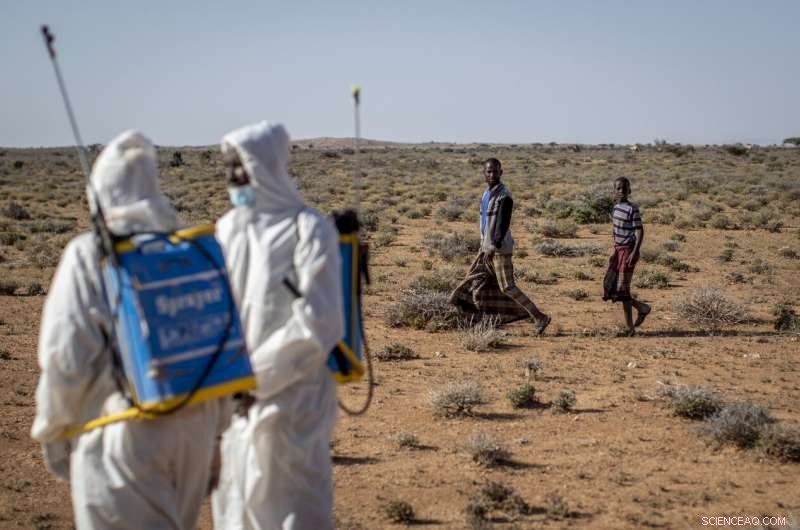
På den här bilden tagen i tisdags, 4 februari, 2020, Somaliska skadedjursbekämpningssprutor demonstrerar sitt arbete på de taggiga buskarna i öknen som är grogrunden för ökengräshoppor för en besökande delegation av somaliska departementstjänstemän och experter från Food and Agriculture Organization (FAO), i öknen nära Garowe, i den halvautonoma Puntland-regionen i Somalia. Ökengräshopporna i denna torra del av norra Somalia ser mindre olycksbådande ut än de miljardmedlemmar svärmar som angriper Östafrika, men de hoppande unga gräshopporna är nästa våg i utbrottet som hotar mer än 10 miljoner människor över hela regionen med en allvarlig hungerkris. (AP Photo/Ben Curtis)
Men att torrare väder inte nödvändigtvis är lösningen, sa Dominique Burgeon, FAO:s nöd- och resilienschef.
Gräshoppornas täthet är nu så hög att även normal fukt kan leda till ytterligare en generation, han sa.
"Vi kan inte tro på Moder Natur för att lösa det, " han förklarade.
Utan tillräckligt med sprutning för att stoppa svärmarna, det redan oroande utbrottet kan förvandlas till en pest, "och när du har en pest, det tar år att kontrollera, " han sa.
Mot den svepande utsikten, några maskerade arbetare med vita skyddsdräkter och bekämpningsmedelsbehållare fastspända på ryggen stod i den kamelkorsade somaliska öknen, spritsar de tusentals gräshoppor som klamrar sig fast vid taggiga buskar.
Världens föränderliga klimat medför risken att fler cykloner kommer in från den värmande Indiska oceanen utanför Östafrika, säger klimatexperter. Med det, sannolikheten för ytterligare gräshoppsutbrott ökar.
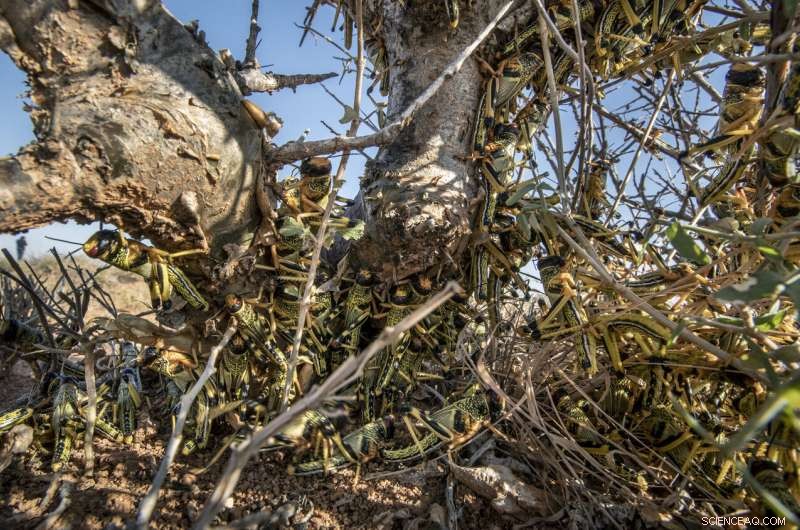
På den här bilden tagen i tisdags, 4 februari, 2020, unga ökengräshoppor som ännu inte fått vingar trängs ihop på en taggig buske i öknen nära Garowe, i den halvautonoma Puntland-regionen i Somalia. Ökengräshopporna i denna torra del av norra Somalia ser mindre olycksbådande ut än de miljardmedlemmar svärmar som angriper Östafrika, men de hoppande unga gräshopporna är nästa våg i utbrottet som hotar mer än 10 miljoner människor över hela regionen med en allvarlig hungerkris. (AP Photo/Ben Curtis)
En sorts ny normal, " sa Burgeon.
Och det betyder Kenya, Etiopien och andra östafrikanska länder som sällan ser sådana utbrott och som befann sig i stort sett oförberedda på detta kunde ansluta sig till "frontlinjeländer" i delar av Västafrika och Mellanöstern, säger experter. Dessa länder har välutbildade övervaknings- och förebyggande system för mer frekventa gräshoppsutbrott.
FAO har bett internationella givare att ge 76 miljoner dollar omedelbart för att hjälpa till att kontrollera detta utbrott. Hittills är 19 miljoner dollar i hand, sa Burgeon.
"Den största utmaningen är omfattningen av aveln, som du kan se runt omkring oss, sade Barca. Dessa gräshoppor, han sa, kommer att migrera till södra Somalia och delar av Kenya och Etiopien precis när grödor gror där.
"Om det vid den tiden finns enorma mängder gräshoppor runt omkring, det kommer att ha en förödande inverkan på skördarna, " sa Burgeon.

På den här bilden tagen i onsdags, 5 februari, 2020, unga ökengräshoppor som ännu inte har fått vingar täcker marken i öknen nära Garowe, in the semi-autonomous Puntland region of Somalia. The desert locusts in this arid patch of northern Somalia look less ominous than the billion-member swarms infesting East Africa, but the hopping young locusts are the next wave in the outbreak that threatens more than 10 million people across the region with a severe hunger crisis. (AP Photo/Ben Curtis)
Other East African countries including Uganda, Södra Sudan, Eritrea and Djibouti are also at risk, Burgeon said. Millions of people in some of these places are already facing hunger in the wake of civil war or more common challenges such as poverty.
Here in rural Somalia, where about 50% of the people depend on animals for their livelihoods, the locusts are eating the pasturage. The animals weaken, their milk decreases and small children, who depend on the milk to survive, suffer skyrocketing malnutrition, the experts said.
Those fighting the locust outbreak may try to negotiate with Somalia's extremist fighters to allow spraying in rural areas where they are active, Burgeon said. Already emergency workers are going in where they can.
In a few weeks the young locusts will shed their skin, said Keith Cressman, a senior locust forecasting officer with the FAO.
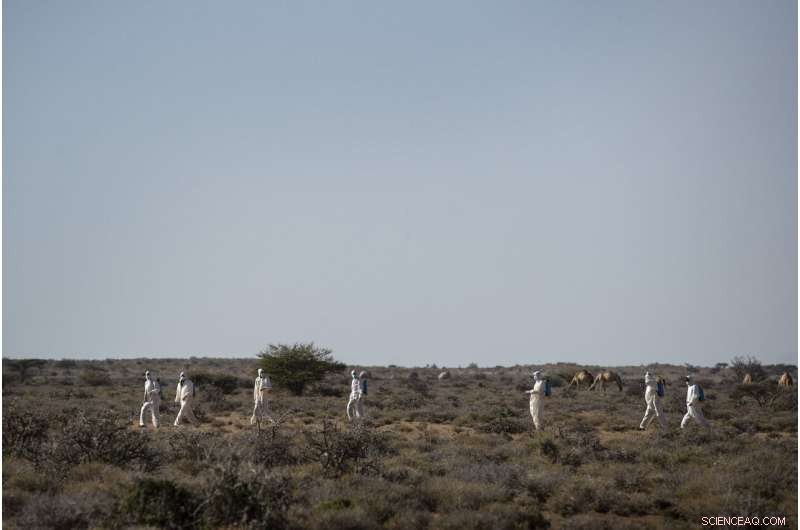
På den här bilden tagen i tisdags, Feb. 4, 2020, Somali pest-control sprayers demonstrate their work on the thorny bushes in the desert that is the breeding ground of desert locusts for a visiting delegation of Somali ministry officials and experts from the Food and Agriculture Organization (FAO), in the desert near Garowe, in the semi-autonomous Puntland region of Somalia. The desert locusts in this arid patch of northern Somalia look less ominous than the billion-member swarms infesting East Africa, but the hopping young locusts are the next wave in the outbreak that threatens more than 10 million people across the region with a severe hunger crisis. (AP Photo/Ben Curtis)
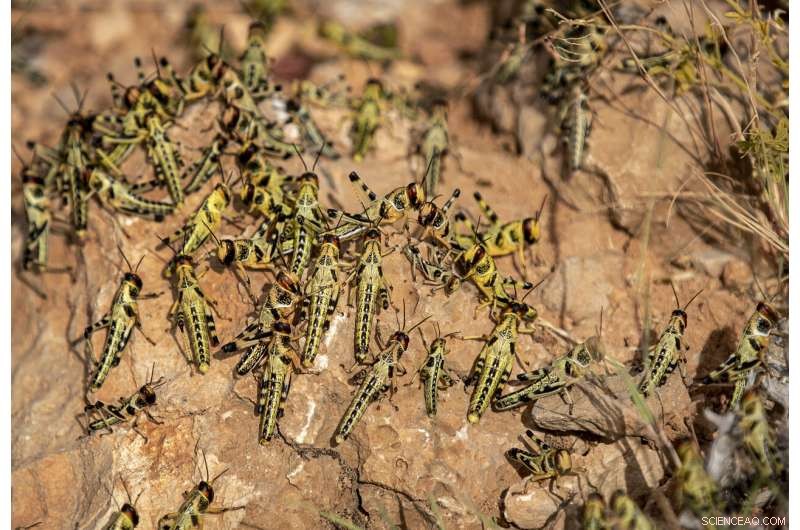
På den här bilden tagen i onsdags, Feb. 5, 2020, young desert locusts that have not yet grown wings crowd together on a rock in the desert near Garowe, in the semi-autonomous Puntland region of Somalia. The desert locusts in this arid patch of northern Somalia look less ominous than the billion-member swarms infesting East Africa, but the hopping young locusts are the next wave in the outbreak that threatens more than 10 million people across the region with a severe hunger crisis. (AP Photo/Ben Curtis)
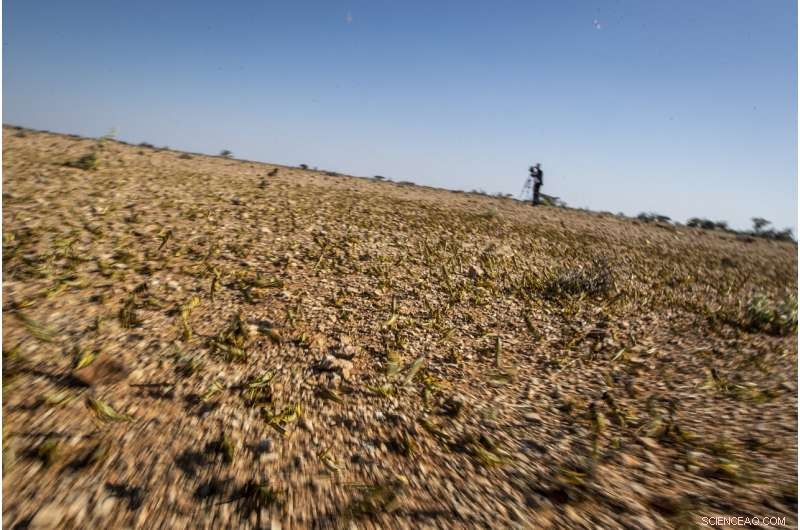
På den här bilden tagen i tisdags, Feb. 4, 2020, young desert locusts that have not yet grown wings jump in the air as they are approached in the desert near Garowe, in the semi-autonomous Puntland region of Somalia. The desert locusts in this arid patch of northern Somalia look less ominous than the billion-member swarms infesting East Africa, but the hopping young locusts are the next wave in the outbreak that threatens more than 10 million people across the region with a severe hunger crisis. (AP Photo/Ben Curtis)
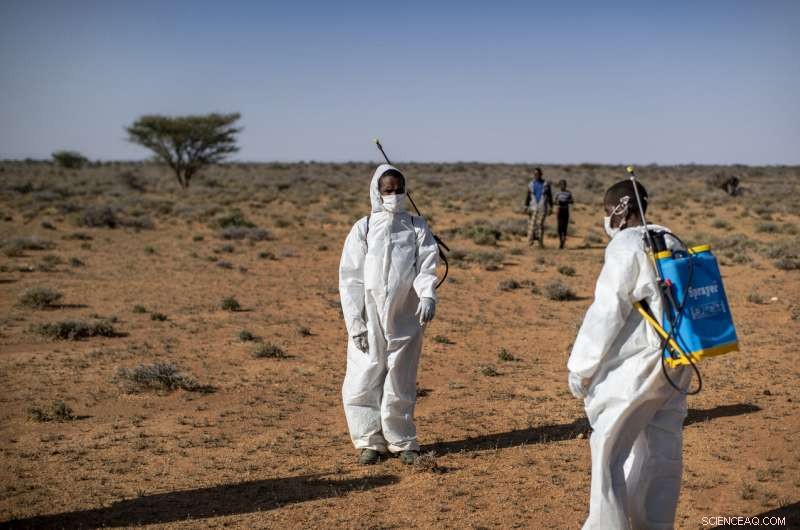
På den här bilden tagen i tisdags, Feb. 4, 2020, Somali pest-control sprayers demonstrate their work on the thorny bushes in the desert that is the breeding ground of desert locusts for a visiting delegation of Somali ministry officials and experts from the Food and Agriculture Organization (FAO), in the desert near Garowe, in the semi-autonomous Puntland region of Somalia. The desert locusts in this arid patch of northern Somalia look less ominous than the billion-member swarms infesting East Africa, but the hopping young locusts are the next wave in the outbreak that threatens more than 10 million people across the region with a severe hunger crisis. (AP Photo/Ben Curtis)

På den här bilden tagen i onsdags, Feb. 5, 2020, young desert locusts that have not yet grown wings jump in the air as they are approached, as a visiting delegation from the Food and Agriculture Organization (FAO) observes them, in the desert near Garowe, in the semi-autonomous Puntland region of Somalia. The desert locusts in this arid patch of northern Somalia look less ominous than the billion-member swarms infesting East Africa, but the hopping young locusts are the next wave in the outbreak that threatens more than 10 million people across the region with a severe hunger crisis. (AP Photo/Ben Curtis)

På den här bilden tagen i tisdags, Feb. 4, 2020, pest-control sprayers demonstrate their work on the thorny bushes in the desert that is the breeding ground of desert locusts for a visiting delegation of Somali ministry officials and experts from the Food and Agriculture Organization (FAO), in the desert near Garowe, in the semi-autonomous Puntland region of Somalia. The desert locusts in this arid patch of northern Somalia look less ominous than the billion-member swarms infesting East Africa, but the hopping young locusts are the next wave in the outbreak that threatens more than 10 million people across the region with a severe hunger crisis. (AP Photo/Ben Curtis)

På den här bilden tagen i tisdags, Feb. 4, 2020, pest-control sprayers demonstrate their work on the thorny bushes in the desert that is the breeding ground of desert locusts for a visiting delegation of Somali ministry officials and experts from the Food and Agriculture Organization (FAO), in the desert near Garowe, in the semi-autonomous Puntland region of Somalia. The desert locusts in this arid patch of northern Somalia look less ominous than the billion-member swarms infesting East Africa, but the hopping young locusts are the next wave in the outbreak that threatens more than 10 million people across the region with a severe hunger crisis. (AP Photo/Ben Curtis)

På den här bilden tagen i onsdags, Feb. 5, 2020, a policeman looks at young desert locusts that have not yet grown wings covering the ground in the desert near Garowe, in the semi-autonomous Puntland region of Somalia. The desert locusts in this arid patch of northern Somalia look less ominous than the billion-member swarms infesting East Africa, but the hopping young locusts are the next wave in the outbreak that threatens more than 10 million people across the region with a severe hunger crisis. (AP Photo/Ben Curtis)

På den här bilden tagen i onsdags, Feb. 5, 2020, an official from the Food and Agriculture Organization (FAO) demonstrates the "eLocust3" software used to record and track the location and movements of locusts using GPS and transmit the data via satellite, in the desert near Garowe, in the semi-autonomous Puntland region of Somalia. The desert locusts in this arid patch of northern Somalia look less ominous than the billion-member swarms infesting East Africa, but the hopping young locusts are the next wave in the outbreak that threatens more than 10 million people across the region with a severe hunger crisis. (AP Photo/Ben Curtis)

På den här bilden tagen i onsdags, Feb. 5, 2020, Dominique Burgeon, Centrum, Director of the Emergency and Resilience Division of the Food and Agriculture Organization (FAO) and Keith Cressman, höger, Senior Locust Forecasting Officer for FAO, walk in the desert between Garowe and Qardho, in the semi-autonomous Puntland region of Somalia. The desert locusts in this arid patch of northern Somalia look less ominous than the billion-member swarms infesting East Africa, but the hopping young locusts are the next wave in the outbreak that threatens more than 10 million people across the region with a severe hunger crisis. (AP Photo/Ben Curtis)
"It takes a few days to warm up their wings, " he said. Some test flights follow and they're on the move.
The locusts at that stage are bright pink and in their most voracious state, like "very hungry teenagers, " Cressman said. By now, many people in Kenya and Ethiopia know them well.
After a month or so, the locusts will be mature adults, ready to reproduce.
Soon after copulating and laying eggs the locusts will die, "but their progeny will be hatching, " Cressman said. "And we have another generation of locusts to contend with, with about another 20-fold increase."
© 2020 The Associated Press. Alla rättigheter förbehållna.